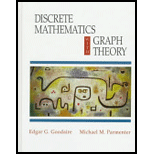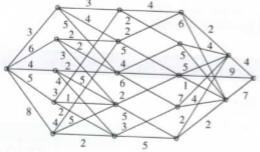
Discrete Mathematics with Graph Theory (Classic Version) (3rd Edition) (Pearson Modern Classics for Advanced Mathematics Series)
3rd Edition
ISBN: 9780134689555
Author: Edgar Goodaire, Michael Parmenter
Publisher: PEARSON
expand_more
expand_more
format_list_bulleted
Textbook Question
Chapter 11.1, Problem 8E
Solve the Chinese Postman Problem for the weighted graph.

Expert Solution & Answer
Want to see the full answer?
Check out a sample textbook solution
Chapter 11 Solutions
Discrete Mathematics with Graph Theory (Classic Version) (3rd Edition) (Pearson Modern Classics for Advanced Mathematics Series)
Ch. 11.1 - Prob. 1TFQCh. 11.1 - Prob. 2TFQCh. 11.1 - Prob. 3TFQCh. 11.1 - In a graph G with two odd vertices, 1 and 2 , the...Ch. 11.1 - If a graph G has six odd vertices, to solve the...Ch. 11.1 - Prob. 6TFQCh. 11.1 - Prob. 7TFQCh. 11.1 - In the weighted graph the Chinese Postman Problem...Ch. 11.1 - Prob. 9TFQCh. 11.1 - In the unweighted graph n, n odd, the Chinese...
Ch. 11.1 - Solve the Chinese Postman Problem for each of the...Ch. 11.1 - Prob. 2ECh. 11.1 - 3. [BB] Solve the Chinese Postman Problem for the...Ch. 11.1 - In a graph G with two odd vertices, 1 and 2 , the...Ch. 11.1 - Solve the Chinese Postman Problem for each of the...Ch. 11.1 - Prob. 6ECh. 11.1 - Prob. 7ECh. 11.1 - Solve the Chinese Postman Problem for the weighted...Ch. 11.1 - Prob. 9ECh. 11.1 - Prob. 10ECh. 11.1 - Prob. 11ECh. 11.1 - Prob. 12ECh. 11.2 - Prob. 1TFQCh. 11.2 - Prob. 2TFQCh. 11.2 - Prob. 3TFQCh. 11.2 - Prob. 4TFQCh. 11.2 - Prob. 5TFQCh. 11.2 - Prob. 6TFQCh. 11.2 - Prob. 7TFQCh. 11.2 - Prob. 8TFQCh. 11.2 - Prob. 9TFQCh. 11.2 - Prob. 10TFQCh. 11.2 - Prob. 1ECh. 11.2 - Prob. 2ECh. 11.2 - Prob. 3ECh. 11.2 - Prob. 4ECh. 11.2 - Prob. 5ECh. 11.2 - Prob. 6ECh. 11.2 - Prob. 7ECh. 11.2 - Prob. 8ECh. 11.2 - Prob. 9ECh. 11.2 - Prove Theorem 11.2.4: A digraph is Eulerian if and...Ch. 11.2 - Prob. 11ECh. 11.2 - Prob. 12ECh. 11.2 - 13. Label the vertices of each pair of digraphs in...Ch. 11.2 - 14. Consider the digraphs , shown.
(a) Find the...Ch. 11.2 - The answers to exercises marked [BB] can be found...Ch. 11.2 - In each of the following cases, find a permutation...Ch. 11.2 - Prob. 17ECh. 11.2 - Prob. 18ECh. 11.2 - [BB] if a graph G is connected and some...Ch. 11.2 - Prob. 20ECh. 11.2 - Prob. 21ECh. 11.2 - Prob. 22ECh. 11.2 - Prob. 23ECh. 11.2 - [BB] Apply the original form of Dijkstras...Ch. 11.2 - Prob. 25ECh. 11.2 - Prob. 26ECh. 11.2 - Prob. 27ECh. 11.2 - Prob. 28ECh. 11.2 - [BB] The Bellman-Ford algorithm can be terminated...Ch. 11.2 - Prob. 30ECh. 11.2 - Prob. 31ECh. 11.2 - Prob. 32ECh. 11.2 - Prob. 33ECh. 11.3 - Prob. 1TFQCh. 11.3 - Prob. 2TFQCh. 11.3 - Prob. 3TFQCh. 11.3 - Prob. 4TFQCh. 11.3 - Prob. 5TFQCh. 11.3 - Prob. 6TFQCh. 11.3 - Prob. 7TFQCh. 11.3 - Prob. 8TFQCh. 11.3 - Prob. 9TFQCh. 11.3 - Prob. 1ECh. 11.3 - Prob. 2ECh. 11.3 - Prob. 3ECh. 11.3 - Prob. 4ECh. 11.3 - Prob. 5ECh. 11.4 - Prob. 1TFQCh. 11.4 - Prob. 2TFQCh. 11.4 - Prob. 3TFQCh. 11.4 - Prob. 4TFQCh. 11.4 - Prob. 5TFQCh. 11.4 - Prob. 6TFQCh. 11.4 - Prob. 7TFQCh. 11.4 - Prob. 8TFQCh. 11.4 - Prob. 9TFQCh. 11.4 - Prob. 10TFQCh. 11.4 - Prob. 1ECh. 11.4 - Prob. 2ECh. 11.4 - Prob. 3ECh. 11.4 - Prob. 4ECh. 11.4 - Prob. 5ECh. 11.4 - Prob. 6ECh. 11.4 - Prob. 7ECh. 11.4 - Prob. 8ECh. 11.4 - Prob. 9ECh. 11.4 - Prob. 10ECh. 11.4 - Prob. 11ECh. 11.4 - Prob. 12ECh. 11.5 - Prob. 1TFQCh. 11.5 - Prob. 2TFQCh. 11.5 - Prob. 3TFQCh. 11.5 - Prob. 4TFQCh. 11.5 - Prob. 5TFQCh. 11.5 - Prob. 6TFQCh. 11.5 - Prob. 7TFQCh. 11.5 - Prob. 8TFQCh. 11.5 - Prob. 9TFQCh. 11.5 - 10. In a type scheduling problem, a vertex that...Ch. 11.5 - Prob. 1ECh. 11.5 - [BB] The construction of a certain part in an...Ch. 11.5 - Prob. 3ECh. 11.5 - Prob. 4ECh. 11.5 - Prob. 5ECh. 11.5 - 6.(a) Find two different orientations on the edges...Ch. 11.5 - Prob. 7ECh. 11.5 - 8. Repeat Exercise 7 if, in addition to all the...Ch. 11.5 - Repeat Exercise 7 if A takes 6 months to complete...Ch. 11.5 - Prob. 10ECh. 11.5 - Prob. 11ECh. 11.5 - Prob. 12ECh. 11.5 - Prob. 13ECh. 11.5 - Prob. 14ECh. 11.5 - Prob. 15ECh. 11.5 - Prob. 16ECh. 11.5 - 17. The computer systems manager in mathematics...Ch. 11 - Solve the Chinese Postman Problem for the two...Ch. 11 - Prob. 2RECh. 11 - 3. Solve the Chinese Postman Problem for the...Ch. 11 - Prob. 4RECh. 11 - Prob. 5RECh. 11 - Prob. 6RECh. 11 - Prob. 7RECh. 11 - Prob. 8RECh. 11 - Prob. 9RECh. 11 - 11. Let and assume that the complete graph has...Ch. 11 - Prob. 11RECh. 11 - Prob. 12RECh. 11 - Prob. 13RECh. 11 - Prob. 14RECh. 11 - Use a version of Dijkstras algorithm to find a...Ch. 11 - Prob. 16RECh. 11 - Prob. 17RECh. 11 - Prob. 18RECh. 11 - Prob. 19RECh. 11 - 20. The following chart lists a number of tasks...Ch. 11 - Prob. 21RE
Knowledge Booster
Learn more about
Need a deep-dive on the concept behind this application? Look no further. Learn more about this topic, subject and related others by exploring similar questions and additional content below.Similar questions
Recommended textbooks for you
 Elementary Geometry For College Students, 7eGeometryISBN:9781337614085Author:Alexander, Daniel C.; Koeberlein, Geralyn M.Publisher:Cengage,
Elementary Geometry For College Students, 7eGeometryISBN:9781337614085Author:Alexander, Daniel C.; Koeberlein, Geralyn M.Publisher:Cengage,

Elementary Geometry For College Students, 7e
Geometry
ISBN:9781337614085
Author:Alexander, Daniel C.; Koeberlein, Geralyn M.
Publisher:Cengage,
Introduction to experimental design and analysis of variance (ANOVA); Author: Dr. Bharatendra Rai;https://www.youtube.com/watch?v=vSFo1MwLoxU;License: Standard YouTube License, CC-BY